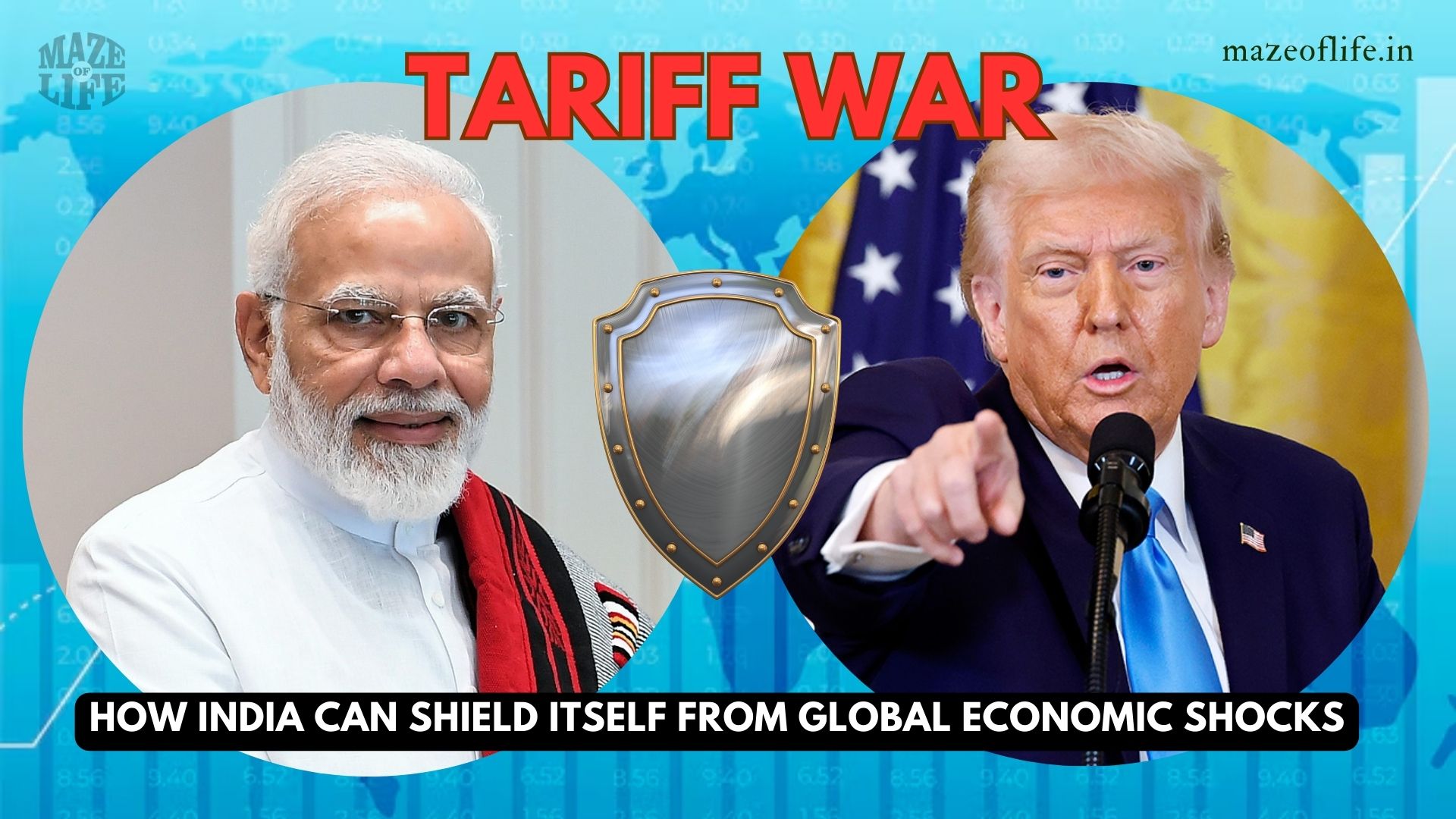In an increasingly economic nationalist, trade war like Trump’s Tariff War, and geopolitically uncertain world, India needs to construct a strategy that is both resilient and forward-looking. The latest round of US tariffs under Trump 2.0 targeting China and allied countries is only one instance of the volatility that emerging economies such as India need to be ready for. A word of caution I am not an Economist or Policy maker or an expert in economics. I am writing this purely as my opinion and how India with its young workforce can not only navigate through the current scenario but also shield itself from such future economic crisis.)
Here’s an in-depth look at how India can battle the present world economic challenges like Trump’s Tariff War and future-proof itself against such disruptions, with simple examples to make each strategy comprehensible:
Strengthen Domestic Demand – The Economy’s Safety Net
Domestic consumption is a balancing factor when international exports decline or foreign capital becomes volatile.
India’s economy is domestically oriented (close to 60% of GDP), providing it with an inherent shock absorber. In the 2008 global crisis, India rode the crisis better than trade-dependent economies such as South Korea or Germany — due to its robust internal demand.
To make this demand robust:
- Invest in rural infrastructure such as roads, connectivity to the internet, and irrigation.
Example: A new highway linking a far-flung village to a closer town can make it easier for farmers to sell their crops, increasing rural incomes and local expenditure. - Increase social safety nets like MNREGA and direct benefits transfers.
Example: A ₹500 a day wage earner from the job scheme is most likely to spend it on vegetables, clothes, and transport — all stimulating the economy. - Offer middle-class tax relief or credit programs to create housing, automobile, and service demand.
Example: Lower mortgage interest rates may motivate a young couple to purchase a home, which in turn creates employment opportunities in construction, furniture, and appliances. - A billion dreams buying a billion products — that’s the India growth story.
Make India the World’s Factory – But Smarter, Leaner, Faster
The world supply chain reset, driven by US-China tensions, presents India with a golden chance to emerge as a manufacturing hub.
But we need to fix:
- Complicated land and labor regulations
- Weak logistics rankings (22nd place in the International Shipments categoory and 38th overall in the World Bank’s Logistics Performance Index (LPI) 2023.
- Policy inconsistency and delay in approvals
How we can Fix this:
- Plug-and-play industrial parks with single-window clearances
Example: A textile firm commencing operations within 3 months because of available factory space and simplified approvals. - Increased Production Linked Incentive (PLI) schemes in strategic sectors such as semiconductors and green tech.
Example: A mobile component manufacturer receives subsidies through PLI to scale up production, cut imports, and generate employment. - Streamlined state-level reforms in land digitisation and enforcement of contracts
Example: A new business discovers land ownership information online and enters into a rental agreement without middlemen hassles. - Apple, Foxconn, and Samsung have already started relocating operations to India. Tesla is on its way to initiate its operations in India. Let us make sure we don’t just manufacture — we design, we innovate, and we lead.
Diversify Trade Partners – Never Put All Eggs in One Basket
Trump’s Trade War taught us how countries can be prone to economic crisis, relying on a single trading partner, such as China or the US, exposes India to geopolitical shocks.
India needs to:
- Enter smart Free Trade Agreements (FTAs) with ASEAN, EU, Gulf nations, and Africa
Example: Indian automobile component manufacturers gaining duty-free entry into Europe through a new FTA. - Strike a balance between tariff concessions and protection for farmers and MSMEs
Example: Maintain more onerous import tariffs on milk to shield domestic cow farmers and reduce tariffs on expensive machinery. - Construct regional leadership in South Asia
Example: Selling cheap vaccines and pharmaceuticals to Bangladesh and Sri Lanka creates goodwill and trade connections. - This prevents any one large economy from slowing down India’s commerce streams.
- Trade diplomacy is warfare today. India has to play it with strategic empathy.
Construct a Strong Financial System – Robust Money = Strong Economy
Capital flight (rapid outflow of assets and capital from country) in times of world uncertainty is an actual threat to emerging economies. The recent FIIs shifting their focus to other markets is a great example. A sound financial system keeps the economy anchored.
Areas of focus:
- Strong public sector banks and decreasing NPAs. The gross NPA ratio, which represents the total amount of bad loans as a percentage of total advances, has decreased to 2.6% while net NPA ratio is 0.6% – a very good sign.
Example: A cleaner bank balance sheet allows for more small business loans at reasonable interest rates. - Deepen domestic bond markets and promote retail participation. As of the end of December 2024, the Indian bond market stood at US$2.69 trillion, with the corporate bond market exceeding US$602 billion, and the outstanding government securities stock at US$1.24 trillion.
Example: A teacher investing ₹5,000 in a state government bond earns better interest than a fixed deposit. - Maintain stable inflation within RBI’s comfort band
Example: Keeping food prices in check helps middle-class families maintain their spending power. - With ~$660 billion in forex reserves and a growing digital finance ecosystem, India is better prepared than before. Let’s keep our financial plumbing strong to withstand any flood.
Invest in Human Capital – India’s Most Underrated Superpower
Youthful population is only an asset if it’s quality-trained. In the direction the world economy is heading towards – AI, automation, and sustainability – India has to invest in future-capable talent.
Moves forward:
- Upgrade skilling programmes in AI, biotech, green energy, and digital tech
Example: A 22-year-old Bhopal lad completes a six-month AI training programme and earns a remote opportunity with a startup in Germany. - Encourage vocational training in addition to conventional degrees
Example: A student is trained to use CNC machines and is placed in a manufacturing facility within 3 months of graduation. - Foster public-private partnerships in education and R&D
Example: An electric vehicle manufacturer partners with an engineering college to provide internships and design facilities. - A billion skilled minds are more valuable than a billion barrels of oil.
Ensure Policy Consistency & Political Maturity
Predictability is more important than growth peaks to global investors. India needs to establish a track record of stable government and long-term policy thinking.
Steer clear of:
- Retrospective taxation and surprise bans
Example: Surprise rice export ban surprises farmers and traders, eroding global confidence in Indian policy. - Regulatory flip-flops
Example: Frequent e-commerce rule changes every couple of months puzzle global investors. - Politicisation of economic choices
- Encourage: Clear tax and trade policies
Example: A clean tax policies with definite timelines increases investor confidence. - Bipartisan collaboration on national purposes such as clean energy and digitalization
Example: Each government carrying solar power goals indicates persistence. - Autonomy of institutions to RBI, SEBI, and judiciary
Example: Independent market watchdog makes financial markets confident. - Confidence is not gained by GDP in isolation — by credible governance.
Conclusion: From Reactive to Resilient
The world will keep on experiencing economic shocks. Rather than just responding to every shock, India needs to develop long-term immunity. With robust domestic demand, intelligent manufacturing, diversification of trade, and quality talent, India can not only weather global storms but come out even stronger from them.
In essence, Atma Nirbhar Bharat is not just a slogan — it is India’s blueprint for resilience in the face of global uncertainty.
Atma Nirbhar Bharat isn’t just about self-sufficiency — it’s about building strength from within. In a world shaken by protectionism and unpredictability, India’s path forward lies in:
- Strengthening domestic demand
- Becoming a smarter global manufacturing hub
- Diversifying trade partnerships
- Fortifying the financial system
- Skilling our youth for the future
- Ensuring policy consistency
It’s not just strategy. It’s economic self-respect.
Jai Hind !!!
For more interesting articles keep visiting Maze of Life.


